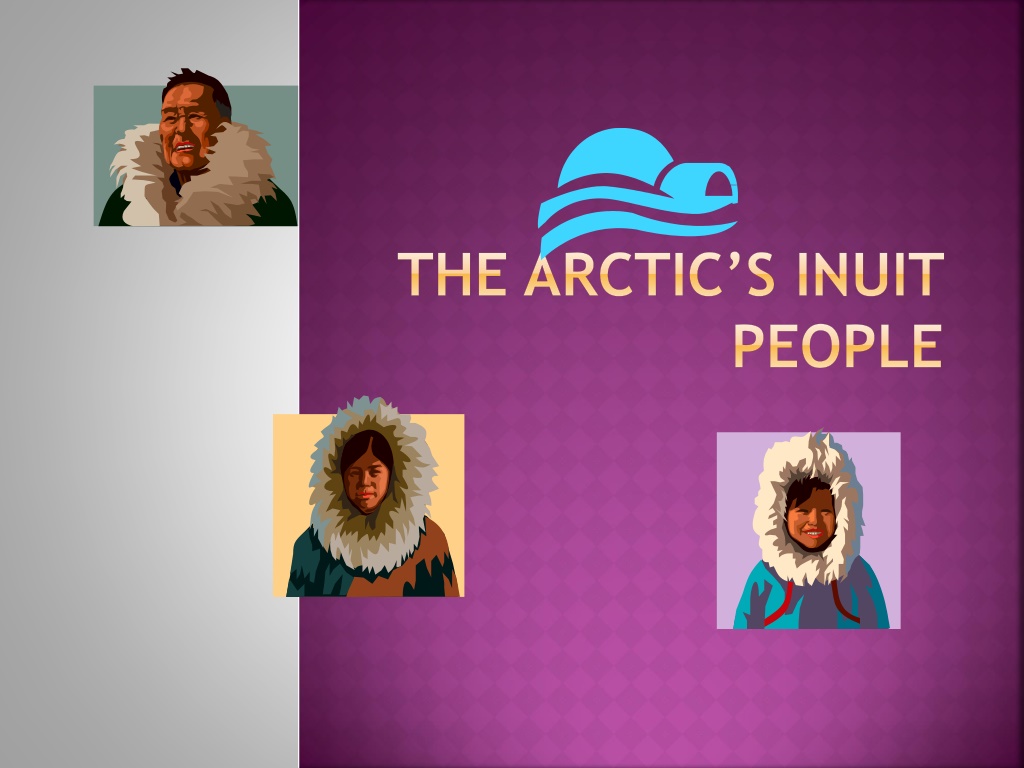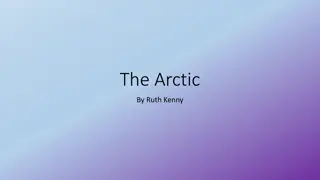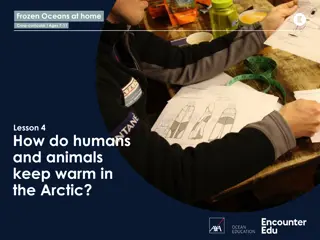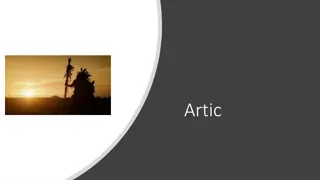Exploring the Inuit Culture and Lifestyle in the Arctic
Learn about the Inuit people of the Arctic, their traditional way of life including homes, transportation, hunting practices, and diet. Discover their rich heritage, language, and population distribution across Greenland, Canada, the United States, and Russia.
Download Presentation

Please find below an Image/Link to download the presentation.
The content on the website is provided AS IS for your information and personal use only. It may not be sold, licensed, or shared on other websites without obtaining consent from the author. Download presentation by click this link. If you encounter any issues during the download, it is possible that the publisher has removed the file from their server.
E N D
Presentation Transcript
THE ARCTICS INUIT PEOPLE
THE INUIT PEOPLE: Inuit, which simply means The People in their own language, refers to the indigenous people of the Arctic. This word has replaced Eskimo in Canada and Greenland, where it is now considered rude; however in Alaska and Russia, it is still accepted as a term to describe the Arctic s Native inhabitants.
POPULATION Altogether about 150,000 Inuit live in the Arctic. They live in Greenland, Canada, the United States (Alaska) and Russia.
LANGUAGE Inuktitut is the traditional language of the Inuit and is still widely used. English and French are also now spoken by the Inuit.
INUIT HOMES- IGLOOS The word igloo means any type of house, not just a snow house. Snow block houses were never used in Alaska. Alaskan and many Russian Inuit lived in cabins made of driftwood covered in soil. In Greenland, Inuit often lived in permanent stone houses. Some Inuit did live in snow block houses during the winter, but moved into animal skin tents during the short summer months. In recent years, many Inuit homes have become more modern. Wooden houses with heat provided by oil- burning stoves are common. However, Inuit housing styles continue to vary greatly depending on location.
TRANSPORTATION Dog Sled Komatik - was the main mode of transportation for the Inuit. Today many dogsleds have been replaced by snowmobiles. Kayak Qajaq - which means hunter boat, was an Inuit invention that is still widely used today. It was traditionally a one person boat made of a light weight driftwood or whale bone frame, covered with stretched animal skins, and finally made watertight with whale fat. The hunter would fasten an outer layer made of seal skin around the cockpit to seal out any water. Umiak- larger and more open boat covered with animal skins. Made to carry larger loads, including entire families.
HUNTING AND DIET The Inuit have traditionally been hunters and fishers. They hunt whales, walruses, caribou, seals, polar bears, muskoxen and birds. In the winter they would hunt seals through their air holes in the ice. They would stand above the holes, harpoon in hand and await the seals return to their breathing hole. Caribou are important for the Inuit; they are used not only for food, but their skins and antlers are used for clothing and tools as well. They hunted with bow and arrow, harpoons, fishing spears and traps. Today the Inuit use modern fishing rods, hooks, nets and traps as well as firearms.
HUNTING AND DIET (CONTD) Because of their food source (only what they killed) the Inuit diet is very high in protein and very high in fat- 75% of their daily energy intake is from fat. It is not possible to grow plants for food in the Arctic; the Inuit have always gathered what is naturally available. They collect grasses, tubers, roots, stems, berries, and seaweed. Because it is much harder to get food in the freezing winter months, the Inuit will dry large supplies of fish in preparation.
CLOTHING Clothing was an important factor in the ability of the Inuit to dwell in such a harsh environment. All clothing was made from various animal skins and hides. In winter they wore two layers of caribou fur clothing Their outer garments were hooded fur jackets called parkas which we still use commonly today. They also wore jackets called Atiqiks. They were made with goose down from geese that were hunted during the spring months. Their boots, called kamiks , were made from seal skin which was warm, durable, and waterproof. The Inuit still wear traditional clothing during the winter and during any long outdoor activity; however, modern ready-made clothes are also popular, especially amongst teenagers
ART, MUSIC AND GAMES The Inuit kept very little other than what was necessary for daily living, which meant much of their entertainment involved no equipment. What they did have they made from natural materials and carved in miniature so they could be carried around or worn.
CARVINGS The Inuit are famous for their soapstone, bone and ivory carvings. Most carvings were pieces used to tell legends or small figures that served as toys for children. The Inuit also carved and decorated their handmade tools. Pieces were often of animals, especially polar bears, seals and walruses, as well as people and other wildlife.
SCRIMSHAW The Inuit engraved pictures that told stories in ivory walrus tusks and whale bones. These tusks depicted stories of whale hunts, dog sledding, caribou, and other various animals and people.
INUKSUK An Inuksuk is a monument made of un- worked stones used for communication and survival. They have been used by the Inuit as guides and markers, pointing out trails, nearby people or even the migration routes of caribou. Inuit tradition celebrates the importance of and forbids the destruction of these monuments.
THROAT SINGING: THE INUITS TRADITIONAL MUSIC. Throat singing is usually performed by two women facing each other, but recently men have begun to take part as well. It is not traditional singing; it uses the voice in a different way. One singer will make deep breathy sounds and produce a short rhythm that she repeats with small breaks in between. The second singer responds during the leaders breaks and they engage in a sort of competition. Click here to hear a sample of throat singing (use Featured Video 03 )
GAMES The Inuit played a variety of traditional games and sports. They usually emphasized skills required for survival in the harsh Arctic environment, though some were simply played for fun. No matter what the purpose of the game, it usually requires no special equipment. Iglagunerk an Inuit laughing game. Each player faces a partner, generally holding each other s hands. At an agreed upon time everyone begins to laugh. The couple that laughs the longest and hardest are declared the winners. The Musk ox Push- With both players on their hands and knees, and heads bent down against each others' shoulders, they attempt to push each other forward out of a designated area. Hands must be kept on the floor. Games played using small pieces included: darts and cribbage boards made of caribou antlers, juggling balls made from caribou hide, bone dominoes and other small bone game pieces.























